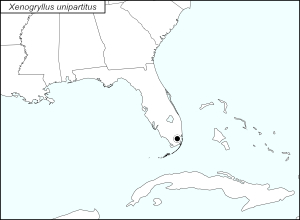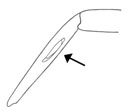




|

|

|

|
| map | male | male | male |

|

|

|

|
| female | female | male | tympanum |
| Alien origin and spread of this SINA species. |

| Song at 25°C: | Sequences of buzzy chirps sometimes delivered at a regular rate of 2-3/s. Chirps have 25–35 pulses at 200 p/s. |
| Remarks: |
Xenogryllus is an Old World genus with six species known in localities from Africa and Bangladesh to Taiwan and Japan. One species of the genus became established in the Homestead area of southern Florida as early as 1993, when it was found on young lychee trees where it was causing damage by laying eggs within the twigs. The young lychee trees had been planted after commercial lychee groves in the Homestead area had been destroyed by Hurricane Andrew in August 1992. Following the hurricane, there had been no known legal source from which to purchase new young trees for replanting—yet new trees were still planted. Taiwan was considered the most likely source of the newly planted trees where the eggs were first found. Thus, TJW sent crickets collected on young lychee trees in the Homestead area to Jeng-Tze Yang, National Chung Hsing University, Taiwan. He identified them as belonging to the genus Xenogryllus but did not determine the species even after I sent more specimens and wav files of the calling songs.
According to OSF, the only Xenogryllus native to Taiwan is X. marmoratus unipartitus (Karny 1915) and its holotype is a female from Takao, Taiwan. In contrast the syntypes of X. m. marmoratus are multiple males and females from Martapocra, Borneo, and Pangerango, Java. Therefore, if the Homestead Xenogryllus population originated in Taiwan, it should be X. marmoratus unipartitus and, considering the geographical separation of Taiwan from Java and Borneo, it seems reasonable to suggest that the Taiwan population be called Xenogryllus unipartitus (Karney 1915). |
| Identification: | Length 16-20 mm. Antennal flagellum black. Anterior tympanum well developed but only partially visible through narrow slit; posterior tympanum well defined and exposed. Lateral ocelli flat, lacking lenses, twice diameter of median ocellus, which has a lens and looks forward; lateral ocellar diameter less than distance between lateral and median ocellus. Male forewings conspicuously wider near tips; greatest width of right forewing more than 30% greater than width at file. Ovipositor 6 mm; shaft more than twice as wide as deep. |
| Similar species: | None. |
| Range: | Xenogryllus is an Old World genus with five species known from localities from Africa and Bangladesh to Taiwan and Japan. One species has recently become established in southern Florida. Its specific identity is under study by Jeng-Tze Yang, National Chung Hsing Univeristy, Taiwan. |
| Habitat: | On foliage within 6 ft. of the ground, especially on lychee. |
| Season: | Perhaps year-round (records of adults are Aug. and Oct.–Nov.). |
| More information: |
Subfamily Eneopterinae. |
| Nomenclature: | OSF (Orthoptera Species File Online). |

|

|